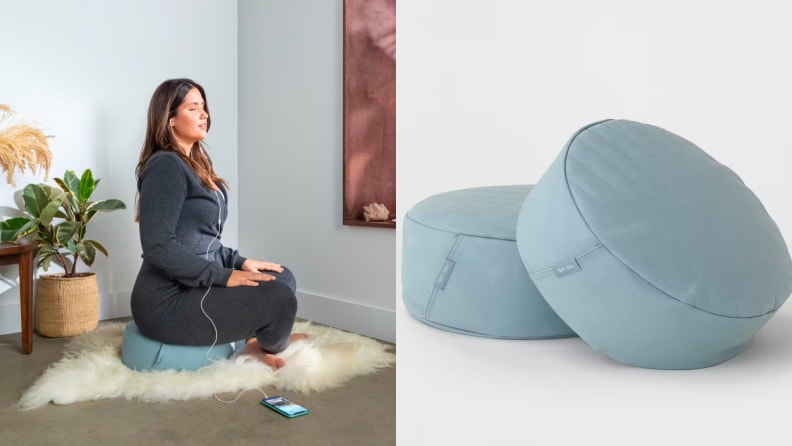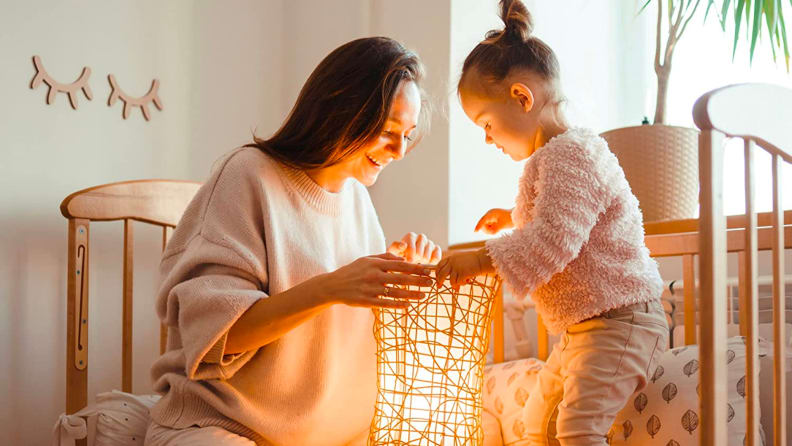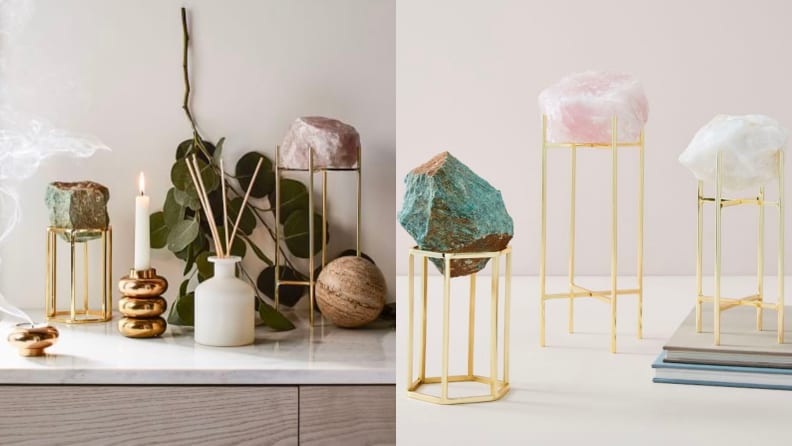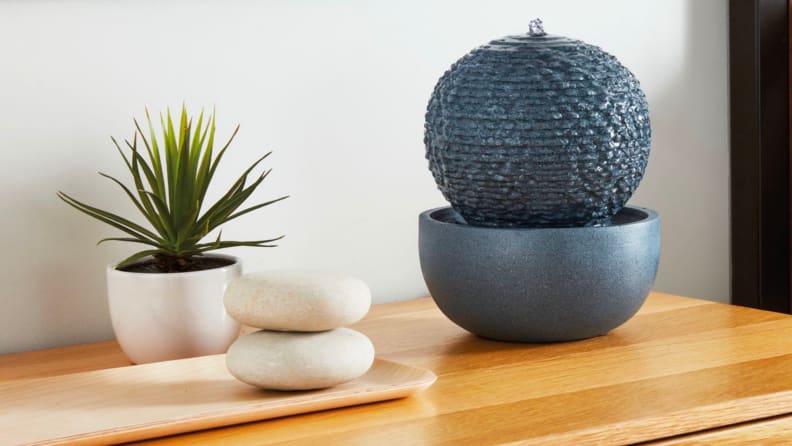Escape the chaos by creating your own Zen den—here’s how
Don’t follow trends, stay true to you
Products are chosen independently by our editors. Purchases made through our links may earn us a commission.
Emotions are running hot right now. Our nervous systems are constantly activated by stressors (looking squarely at you, COVID-19), and they’re in desperate need of a rest.
While Pinterest searches for “rage rooms” have seen a 150% uptick in the past year, according to the company’s December 2021 trend report, a more relaxing approach to destressing could be what we really need.
Christina Simon of Mark Ashby Design in Austin, Texas, explains, “Because of work, the new multi-tasking of the pandemic-era home, busy children, and messy pets, we can easily build up a lot of visual noise. Having one spot in the house that remains spartan, deliberate, and always tidy helps calm the mind.”
While this could easily just translate to a family agreement to keep a bathroom organized and spa-like, a year like 2022 deserves a next-level retreat to practice mindfulness.
Build your own, keep it simple
If you need a safe space to go for all the feels, there’s a room for that. Consider creating a great (indoor) escape to decompress in your home.
Author Jessie Asya Kanzer built her own Zen den in her Dobbs Ferry, N.Y., home. “I didn’t realize how badly I needed a Zen space until I created it,” she says. And she should know; she has a book coming out called, “Don’t Just Sit There, Do Nothing: Healing, Chilling, and Living with the Tao Te Ching.”
Of her special space, Kanzer says, “It’s the place I go to write, meditate, and to just breathe. So much of our lives is about taking care of others or of our obligations—children, partners, pets, jobs. Creating a Zen space is about taking care of yourself.”
Rachael H. Grochowski, a yoga instructor and founder of RHG Architecture & Design in Montclair, N.J., focuses on the reciprocal nature of design and wellness through her projects.
When designing a personal wellness space, the first question she wants you to ask yourself is, “What makes you feel grounded, [or] safe to let everything go?”
Address your needs, whether it be aromatherapy, tons of pillows, inspirational books, music, nature sounds, white noise, or simple silence.
“Limit the contents of your wellness to what’s meaningful to you,” she says. “Remove the excess, so you can focus on what you value and [what] makes you feel at peace.”
A safe haven doesn’t need to be big or fancy. When you spend time there, you recharge your soul.
Kanzer says, “An ‘escape’ room is integral to our ability to disconnect from the world, even if this room is merely a closet with a cushion to sit on. To have a place you can call your own that is dedicated to your mental and spiritual wellbeing is such a powerful statement to yourself and to the universe. It means you're committed to taking care of ‘you’ at the deepest level.”
Don’t let square footage dictate your design

Add a sense of calm with this plush cushion.
Everyone can enjoy a Zen den, even when your square footage isn’t conducive to a huge meditation space full of waterfalls and lounge chairs.
Kanzer says, “When creating a wellness space, you've got to work with what's on hand.” Her Zen den is also her office and a guest room thanks to her use of modular furniture to efficiently outfit the area.
Kanzer says to ask yourself how you want your room to feel. Then, “pick a nook of that room that you're dedicating to zenness and go from there. Start with one piece that encompasses this feeling for you.”
Her choice: a simple brass enso circle, a sacred symbol said to represent the artist in the moment of creation, as well as enlightenment, acceptance of imperfection, and the art of letting go.
She designed her space with meaningful artwork, a meditation cushion, and a simple vase with flowers.
- Get the Metal Enso Circle Wall Art at Etsy from $35
- Get the Calm Meditation Cushion at Tuft & Needle for $80
Appreciate the impact and importance of lighting

Screw in light bulbs that have a warm glow.
Sometimes we need stimulation and other times we need calm. Ideally a space focused on wellness has abundant natural light, which boosts the mood, combined with adjustable lights for when it’s quiet time. Overall, the secret to a relaxed and inviting environment is low, warm lighting.
Natural light is incredibly important for people. If you can create a space for yourself near a window or in front of a window, that's ideal. But, if natural light in the space is limited, make sure you give yourself options where you can keep the lighting really soft.
Simon says, “Harsh overhead shadows are not the mood we’re looking for in a relaxed environment.” She suggests installing lamps and fixtures that glow (light color shades work well for this) in varying heights to prevent all lighting coming from one direction.
“Purchase bulbs that have warmer, more relaxing tones versus blue-er ‘natural daylight’ bulbs best for tasks.”
Get the Brilli Relaxing Wind Down Wellness Light Bulb
Provide ways to engage your senses

Add to the ambiance with crystals and natural stones.
Grochowski says, “Wellness spaces allow us to come into our body. To feel all the feelings.”
Translation: Get ready to engage all of you. Bring nature in through plants and crystals; candles, essential oils, potpourri, or incense for your strongest sense—smell; soft textures in pillows, blankets or rugs for a tactile retreat; music that makes you feel; and even pleasant tastes like warm tea or dark chocolate. Keep a bowl of small pieces for the occasional nibble and an earthen-ware pitcher filled with fruit-infused water so you can replenish your body with hydration as you relax.
Kanzer adds, “It’s important to engage other senses, whether via a candle, incense, or a wind chime outside your window. What happens is you create a reflex, so that when your body sits on your meditation pillow and smells the incense, for instance, it automatically relaxes.”
- Get the 17-piece Chakra Box at Etsy for $63
- Get the Wavy Pitcher Sierra at Nouveau & Vintage for $78
- Get Natural Stone on Stand Objects at West Elm, set of 2, from $56
- Get the Ritual Rug from Ma Wovens for $188
Let elements of the natural world ground you

Connect to small elements of nature.
While our civilization is a hectic one, turning to nature always helps to soothe the world around us.
Laura Rhodes-Levin, founder of The Missing Peace Center for Anxiety in Agoura Hills, California, says, “For our facility, nature is a key component in creating our environment. Nature invokes an innate centering and grounding feeling. Our emotions come from a more primitive part of our brains, so it is important to soothe the savage beast inside each of us.”
Throughout the facility, she uses soft, warm earth tones like sage green, buttery yellow, terracotta and sky blue, as well as lighting concepts such as stars on the ceiling. She also relies on water features and tactile techniques such as putting sand on the floor where appropriate as grounding tools.
Nature can have a profound effect on space and the mind in general, adds Simon. “Instinctually we know that seeing the outside world and feeling connected to it is grounding.”
If you can’t have oversized windows overlooking a Japanese garden, bring a plant indoors to achieve that feeling. In the same vein, natural fibers, untreated woods, and organic shapes can make a space feel lovely.
Get the Bloom Tabletop Fountain at Bed Bath & Beyond for $40
Stay true to you
To have a successful escape room, you only need to listen to yourself. Because not all of us relax in the same way.
Kanzer says, “My big décor tip is to ignore all the décor tips. Connect with yourself, your needs, your preferences. This space should be about pleasing yourself and allowing yourself the room to recharge. Ask yourself, what do you need for that?”
Often, it's less than you'd think.
The product experts at Reviewed have all your shopping needs covered. Follow Reviewed on Facebook, Twitter, Instagram, TikTok, or Flipboard for the latest deals, product reviews, and more.
Prices were accurate at the time this article was published but may change over time.


